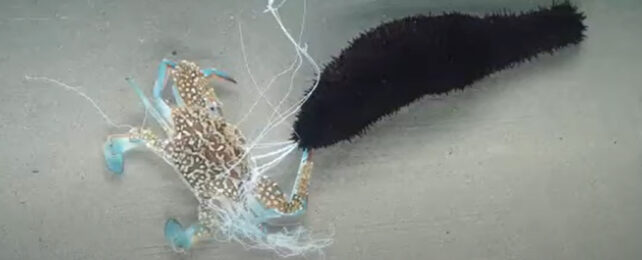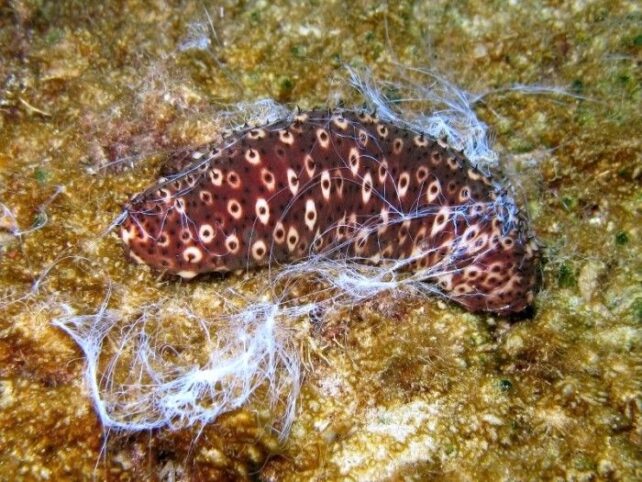
Squirming slowly along the ocean floor, sea cucumbers look like an easy target to hungry predators. But at the slightest provocation, these chunky tube animals tear a hole in the wall of their own butt and cast out a tangle of fine, sticky, noodles.
Stress-induced butt-vomiting might sound comical, but it serves a useful purpose – the eviscerated organs of some sea cucumbers (like the black sea cucumber, Holothuria leucospilota) can entangle and neutralize predators.
According to a new study, the expellable innards – called Cuvierian organs – are composed of proteins similar to spider silk.
First described in 1831, the Cuvierian organ has hundreds of tubules that dangle from the base of the sea cucumber’s breathing organ called a respiratory tree (these animals also breath through their butts). Their far ends float freely within the fluid of the sea cucumber’s body cavity.
“[S]timulus-selective response in H. leucospilota may be turned on only when an encroaching predator exerts a sufficiently large physical force directly onto the Cuvierian organ,” the researchers explain.
They traced the molecular pathway that triggers the organ’s dramatic deployment and found that touching the animal’s skin or piercing it with a needle, weakly activated the organ, where direct pressure didn’t.
Genetic analysis revealed the tubules’ membranes are formed from long, repeating sequences of amino acids, similar to those found in spider webs or silkworm threads. These proteins give the organ its high tensile strength, and while their repeating nature is familiar, the proteins themselves and their arrangements are unique.
Within moments of entering the ocean the mess of tubules dramatically expands up to 20 times their original length, thanks to water pumping inside them from the sea cucumber’s respiratory tree. On contact with any surface, the tubules instantly become sticky, clinging stubbornly to any offending toucher, like a crab, and entangling them, sometimes leading to the attacker’s death.
 (Roberto Pillon/World Register of Marine Species/CC BY-NC-SA)
(Roberto Pillon/World Register of Marine Species/CC BY-NC-SA)
The researchers also found amyloid-like patterns in proteins within the Cuvierian organ’s outer membrane. Infamous for their implication in Alzheimer’s disease in humans, amyloid proteins are also used by other marine organisms like barnacles as a strong adhesive. Chen and colleagues suspect this may also be the role they play within the Cuvierian organs as well.
“This study provides the first genomic insights into defensive ensnarement in a representative species of [sea cucumber],” South Sea Institute of Oceanology marine biologist Ting Chen and colleagues write in their paper.
Once expelled, the sea cucumber is able to self-amputate its Cuvierian organ, like a lizard dropping its tail in a process called autotomy. It takes as little as 15 days for black sea cucumbers to fully regrow these viscera, armed and ready for the next predator who dares try to mess with them.
Safe from attack, the sea cucumber will then crawl away from the deadly mess it created, presumably to hide, as they’re often found partially concealed under boulders, corals or clumps of seaweed. Here, they filter organic matter from the sand, recycling nutrients like calcium by pooping them back into the water where corals and other animals can slurp them up.
A genetic analysis conducted as part of the investigation also suggests that sea cucumbers parted evolutionary ways with sea urchins around 537 million years ago.
But who needs a coat of spikes when your butt can impersonate Spiderman at a moment’s notice?